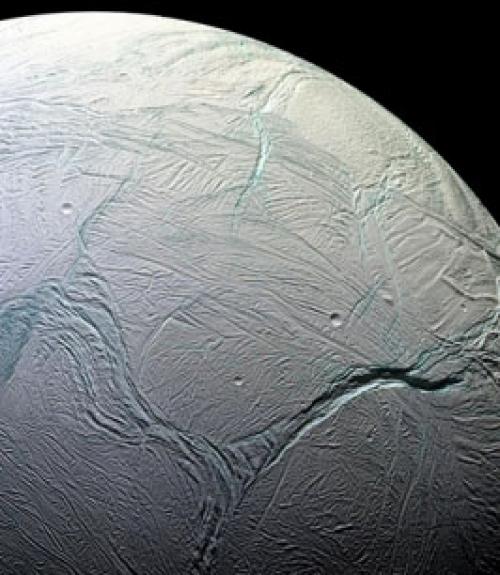Galactic hitchhikers take note: The restaurant at the end of the universe may be closer than we think.
After probing data from NASA spacecraft Cassini’s flight through the watery plume of Saturn’s icy moon Enceladus, scientists from the Southwest Research Institute, Johns Hopkins’ Applied Physics Lab and Cornell confirm the presence of molecular hydrogen – a potential microbial food source and an ingredient necessary for life. The new research is published April 14 in Science.
Under Enceladus’ frozen surface lies an ocean. Through cracks on the façade of this frostbitten moon, misty plumes jet above the surface. During its deepest and last dive through the plume on Oct. 28, 2015, Cassini sampled the spray’s composition using the ion and neutral mass spectrometer, or INMS. Research bears out that hot water is reacting chemically with rock on the moon’s seafloor, producing molecular hydrogen.
“This is the restaurant at the bottom of the ocean in Enceladus. The water reacts with the rock and you can get molecular hydrogen, depending upon what minerals are present,” said Jonathan I. Lunine, the David C. Duncan Professor in the Physical Sciences. “If life has gained a toehold there, it’s got a primitive, yet perfectly good, food source that could allow it to persist. This Cassini result shows us that Enceladus is really the place to go to look for life.”
The research, “Cassini Finds Molecular Hydrogen in the Enceladus Plume: Evidence for Hydrothermal Processes,” was funded by NASA.
The Cassini spacecraft’s instruments do not have the capability to detect life. In fact, scientists hadn’t realized that the venting plume on Enceladus existed until the mission detected it 12 years ago. “Although we can’t detect life, we’ve found that there’s a food source there for it. It would be like a candy store for microbes,” said lead author Hunter Waite, program director at Southwest Research Institute.
Much like on Earth’s ocean floor, the moon’s core warmth could provide undersea microbes a chance to thrive. The new paper reports that the detected molecular hydrogen is dense enough to support microbes and may help create a larger ecosystem.
“Enceladus has organic molecules, it’s got salts, mineral grains, silica grains,” said Lunine. “Now we have detected molecular hydrogen, and through a process called serpentinization, where rock becomes nutrition, we get the stuff of life.”
Lunine said that although current cosmic exploration has found thousands of exoplanets in habitable zones, scientists are unsure whether the origin of life requires special circumstances, or more simply water, organics, minerals and energy.
“It is important to look for life in another part of our solar system – close enough that we can find it,” said Lunine. “If we do eventually find life on Enceladus, then life forms wherever conditions are suitable. That would tell us that the universe is teeming with life.”
This article originally appeared in the Cornell Chronicle.




